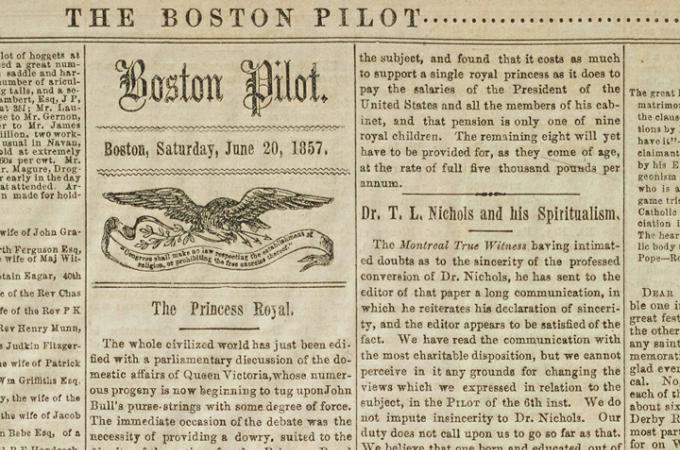The controversial conversion of Dr. T.L. Nichols
In the papers of Bishop John B. Fitzpatrick of Boston exists a letter dated June 27, 1857, from "T.L. Nichols." He writes from Saint Martins, Brown County, Ohio, informing the bishop of an article in The Pilot questioning the sincerity with which he and his wife converted to the Catholic faith.
A search yielded a series of articles about the Nichols' conversion spanning April through August 1857. On April 25, The Pilot reprinted an article that first appeared on March 30 in The Catholic Telegraph of Cincinnati, Ohio. Titled "Important Conversions," the editors claim that they "care not to publish conversions to the Catholic faith. But some are of such a nature as to escape from beneath the veil that would conceal them."
It continues "Dr. (T.L.) and Mrs. (Mary S. Gove) Nichols" were baptized the previous day at St. Francis Xavier Church in Cincinnati. Prior to that event, the couple submitted to ecclesiastical authorities a written retraction of previous actions and writings that did not coincide with Catholic teachings, a copy of the text concluded the article.
In the retraction, the Nichols reveal themselves to be socialists, followers of Charles Fourier, in pursuit of a "unitary, or harmonic society." They realized that the goal of "social regeneration could be possible only in an orderly and holy life," and though they labored with honesty and zeal, they were misguided. Other socialists would join them, they claim, if they also realized the Catholic Church would help achieve their aims.
The Nichols provided more detail in a second article published May 16. Briefly, in 1854, Mrs. Nichols became a "subjected medium for spiritual manifestations, and communications." They claim not to have accepted bad messages from spirits, only "what came to our highest sense of right, and what commended itself most graciously to our faith, and most clearly to our reason."
In 1856, while in a séance, a spirit appeared to Mrs. Nichols, declared himself a Jesuit priest, and claimed they sought the same goal as his Society. The Nichols maintain they had no prior knowledge of Jesuits or Catholicism; Dr. Nichols began to read a history of the Jesuits, but Mrs. Nichols ignored the Jesuit because her guardian spirit did not introduce him.
Six months later, another spirit introduced himself as Gonzales, an early Jesuit martyr, and later a spirit who identified himself as St. Francis Xavier and taught them about the sacraments. The Nichols conclude that "with these sublime teachings came an influence which melted all who heard them. God's grace seemed to be infused into our souls hearts; we bowed humbly to this sweet influence, and faith was born in our souls."
A response published on June 6 outlined why so many doubted the sincerity of the Nichols' conversion. First, the author states, the Nichols do not seem to have abandoned spiritualism, but rather converted to Catholicism at the urging of these spirits. Furthermore, they find Catholicism appealing only because it corroborates their belief in socialism, and therefore "subordinates the faith to their own previous convictions." He admits that Catholics cannot doubt saints miraculously appeared to the Nichols, but he does question that two seemingly educated people knew nothing of Jesuits or Catholicism prior to those events, and the motive for hastily publishing their story.
In his letter to Bishop Fitzpatrick, Nichols admits writing him not as the one "responsible for the conduct of The Pilot, but as the religious superior...of its conductors." He continues to reveal that he learned of the article published in The Pilot only after reading a response in his defense published in the Catholic Standard of New Orleans. He admits the scrutiny might be deserved but wishes to make clear that past actions were the result of an "honest, but misguided ultimation of the Protestant doctrines of the right of private judgement and the sovereignty of the individual."
The letter was approved by Archbishop John Baptist Purcell of Cincinnati and intended for private circulation, if the introductory letter was also printed, he claims, it would provide context to the document and make clear the reasons for converting.
Nichols and his family are now Catholics and so, he challenges, is his current status also open to criticism in The Pilot? If so, do they also criticize his teachers, the archbishop of Cincinnati and the Jesuit Fathers at St. Xavier College who have guided them through their spiritual journey? As a Catholic he "expect(s) the abuse of Protestants and infidels" but does not think he should be "subject to the criticisms or censures of Catholic laymen." He continues to ask if Bishop Fitzpatrick "would consider an attack as that of The Pilot, on persons received into the Church under your direction, as within the province of a distant editor?"
He admits having spent his life in ignorance and sin, and now intends to devote the remainder of it to his new faith, reiterating the sincerity with which he has converted. He concludes that he will accept the criticism against him with humility and hopes that all good Catholics will pray for him and other converts.
It appears that one more article followed in The Pilot, in August 1857, in which Dr. Nichols once again attempted to explain their conversion.
Those wishing to read these articles, and many other early editions of The Pilot, can do so by visiting newspapers.bc.edu.
- Father Thomas Ryan, CSP, directs the Paulist North American Office for Ecumenical and Interfaith Relations in Boston.



















